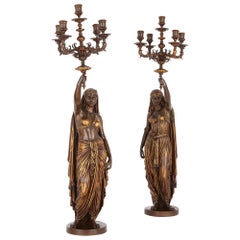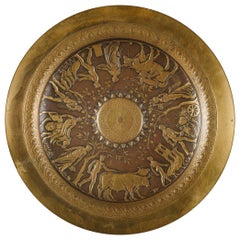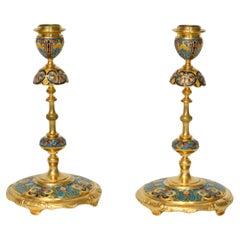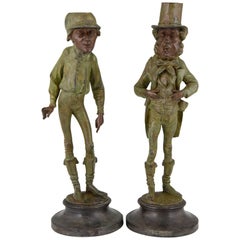Émile Guillemin Candle Holders
Émile Guillemin was a celebrated 19th-century French sculptor whose Victorian-era masterpieces showed a deep love and appreciation for Asian and Middle Eastern cultures. He worked with the esteemed Barbedienne Foundry to create bronze figurative sculptures of exquisite detail. He also made statuesque bronze floor lamps and glinting silver centerpieces that retain their luster and charm to this day.
Guillemin was born in Paris in 1841. His father was sculptor Auguste Guillemin, who worked for aristocrats producing copies of ancient busts. Guillemin studied under his father and under sculptor Jean-Jules Salmson. He first exhibited his work at the Paris Salon of 1870 with two statues of Roman gladiators and continued showing his work at Paris Salons over the next three decades.
Although Guillemin was a prolific sculptor with a wide-ranging repertoire, he is most known for his Orientalist-style pieces, a term denoting the exoticization of Asian and Middle Eastern art in the West. What made Guillemin's work stand out was the great sensitivity and care he put into depicting his subjects in an accurate manner. From Japanese courtesans to Indian falconers, his subjects don accurate re-creations of the clothing, hairstyles and accouterments of their cultures.
Today, Guillemin's pieces remain in high demand. In 2008, a pair of busts he crafted in 1884, called Femme Kabyle d'Algerie and Janissaire du Sultan Mahmoud II, sold at auction for more than $1 million.
On 1stDibs, find Émile Guillemin sculptures, lighting and tableware.
Late 19th Century French Neoclassical Antique Émile Guillemin Candle Holders
Bronze
19th Century French Neoclassical Revival Antique Émile Guillemin Candle Holders
Bronze
1880s French Chinoiserie Antique Émile Guillemin Candle Holders
Bronze, Enamel
1790s European Neoclassical Antique Émile Guillemin Candle Holders
Bronze
Early 19th Century English Neoclassical Antique Émile Guillemin Candle Holders
Bronze
Late 19th Century Neoclassical Antique Émile Guillemin Candle Holders
Bronze
19th Century Antique Émile Guillemin Candle Holders
Bronze
19th Century French Louis XV Antique Émile Guillemin Candle Holders
Marble, Bronze, Ormolu
19th Century French Antique Émile Guillemin Candle Holders
Bronze
19th Century French Antique Émile Guillemin Candle Holders
Bronze
1860s Antique Émile Guillemin Candle Holders
Bronze
Mid-19th Century French Antique Émile Guillemin Candle Holders
Bronze
1870s French Antique Émile Guillemin Candle Holders
Bronze, Ormolu
Early 20th Century French Art Nouveau Émile Guillemin Candle Holders
Metal



